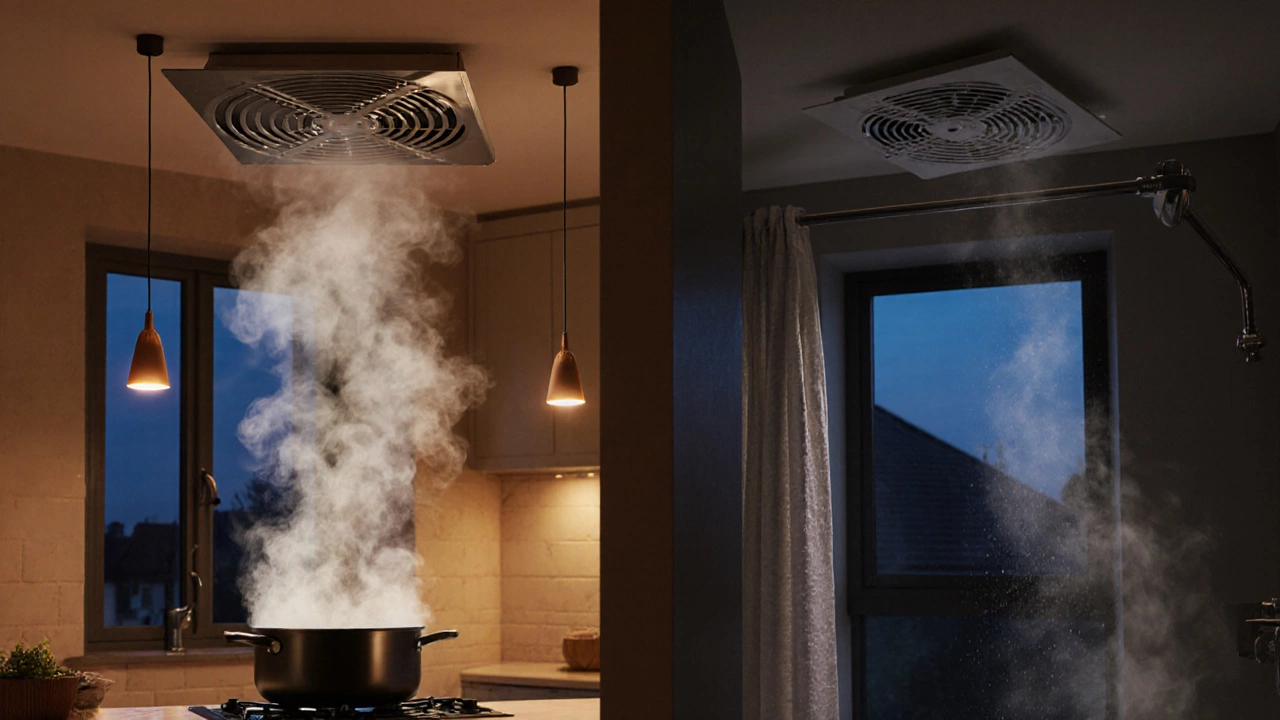
- 6 Nov 2024
- Gideon Thornton
- 0
When we think of improving our indoor air quality, fans come into play as silent allies. But with different names and functions, like ventilation and extractor fans, confusion might arise when choosing or maintaining them. Sorting out these differences isn't just for tech experts—it's for anyone looking to keep their house comfortable and air fresh.
Ventilation fans work to circulate air, while extractor fans are designed to remove particular odorous or moist air from specific areas. This small but essential distinction plays a significant role in various settings, be it the steamy bathroom or the fragrant cooking nook.
Understanding how each operates and where they thrive best will guide you to not only repair but also optimize their use around your home. It turns out, a little bit of fan knowledge can greatly enhance your living space.
- Understanding Ventilation Fans
- The Role of Extractor Fans
- Key Differences Between Ventilation and Extractor Fans
- Common Issues and Repair Tips
- Choosing the Right Fan for Your Needs
Understanding Ventilation Fans
When we dive into the world of ventilation fans, it's like peeling back layers of an onion, revealing a complex system beneath a simple exterior. Designed primarily to promote air circulation, these fans play a crucial role in maintaining control over indoor air quality. Unlike their cousin, the extractor fan, the purpose of a ventilation fan is not to remove, but rather to keep the air moving within a space. This function is particularly vital in areas of the house where stagnant air could lead to discomfort or health issues. For instance, rooms such as basements or attics often lack natural airflow, making them prime candidates for ventilation fans.
Ventilation fans come in various forms, from the ceiling-mounted models you'll often find in bathrooms and kitchens to larger, industrial-scale versions used in commercial buildings. Each type is tailored to the specific needs of its environment. Residential fans are typically quieter and more energy-efficient, designed to blend seamlessly with home decor and function. In contrast, larger fans prioritize power and capacity, often installed in places like warehouses or factories where air circulation is not just important, but essential for maintaining worker safety and equipment longevity. The variety of designs and power levels enables anyone, from a small apartment dweller to an industry giant, to find a fan that fits their particular needs.
Interestingly, these fans are not only about moving air. They also contribute to energy efficiency by reducing the strain on heating and cooling systems. Enhanced air circulation means less energy required to maintain a comfortable temperature. This can lead to significant savings on energy bills over time. According to a study by the U.S. Department of Energy, proper ventilation can improve HVAC efficiency by up to 20%. Such stats underscore the added economic benefits that come with making the right ventilation choice.
Given their importance, maintenance and installation need thoughtful consideration. It's often suggested to place the fan where airflows naturally lead, enhancing its effectiveness. Regular cleaning of fans is paramount to prevent dust buildup, which can impair function and reduce lifespan. Some enthusiasts even undertake the task of DIY maintenance, equipped with nothing more than a screwdriver and a trusty vacuum cleaner - because the buildup of dust or grime can significantly hamper a fan's operations.
"Proper ventilation is the foundation of indoor air quality. When used correctly, ventilation technology can prevent a wide array of environmental issues," says Dr. James Peterson, a notable expert in the field of environmental health studies.
By ensuring your ventilation systems are working efficiently, you not only maintain greater air quality but also extend the longevity of your larger air conditioning or heating units. It's steps like these, small yet significant, that differentiate a well-maintained house from one that constantly needs repairs. Whether you're replacing an old fan or installing a new system, understanding what a ventilation fan offers is the first step to achieving a comfortable and healthy living environment.
The Role of Extractor Fans
Extractor fans are specifically designed to maintain indoor air quality by removing unwanted elements, such as moisture and odors, from the air. They are often found in areas that are prone to dampness or strong smells, like kitchens and bathrooms. These spaces can easily become breeding grounds for mold and mildew due to humidity, or they can harbor lingering odors from cooking or smoking. By whisking away this polluted air, extractor fans help to create a more pleasant living environment. Extractor fans do not merely push air around; they actively eliminate problematic air by channeling it outside, ensuring that fresh air takes its place. A well-functioning extractor fan not only improves air quality but also preserves the structural integrity of your home by reducing humidity-related damage.
One of the fascinating aspects of extractor fans is their diversity in functionality and design, tailored to specific needs. For instance, kitchen-range hoods often incorporate extractor fans that capture grease, smoke, and odors during cooking. This is critical in maintaining a clean cooking environment and preventing grease buildup on walls and ceilings. In bathrooms, these fans are crucial after hot showers, which can fill the room with steam and moisture, leading to the aforementioned mold problems. More advanced models even come with moisture sensors, automatically activating when humidity levels rise. This feature not only improves efficiency but also simplifies usage, ensuring the fan does its job without requiring manual operation each time.
According to a study by the Environmental Protection Agency (EPA), indoor air can sometimes be more polluted than outdoor air. This highlights the importance of a well-placed extractor fan, which acts as an essential tool in combating this issue. The growing awareness about indoor air quality has further accentuated the role of extractor fans in homes and commercial spaces.
"With increased insulation in modern homes, ensuring adequate ventilation via extractor fans is more critical than ever," states an HVAC professional from a leading home improvement brand.Combining these insights stresses the necessity of understanding and leveraging the benefits of extractor fans adequately.
When considering an extractor fan, various aspects such as size, placement, and capacity must be taken into account to ensure optimal functionality. For larger spaces or commercial kitchens, industrial-grade fans might be necessary to handle the volume of air and contaminants efficiently. It's crucial to choose a fan that matches the size of the area and the nature of the air it will need to handle. Installing an undersized fan can lead to inefficiency, while a fan too large can waste energy. To prevent heat loss, some fans are equipped with heat recovery systems, making them not only effective but energy-efficient as well.
Another interesting fact about extractor fans is their impact on energy efficiency in homes. By removing warm, humid air that requires more energy to cool, they indirectly contribute to reducing energy consumption. This makes them not just a tool for addressing air quality but also an ally in lowering utility bills. In some regions, homes equipped with energy-efficient extractor fans might qualify for certain tax deductions or incentives, underlining their value in sustainable living practices. Understanding their role, therefore, traverses beyond immediate air quality improvements to encompass long-term economic and environmental benefits.

Key Differences Between Ventilation and Extractor Fans
While both ventilation fans and extractor fans play crucial roles in enhancing our indoor air environments, their functionalities diverge significantly, aligning them with distinct purposes. Ventilation fans are primarily tasked with moving air around a space. They aim to freshen up entire rooms by circulating air through the building itself. This circulation can bring in fresh outdoor air, balancing indoor humidity and temperature to a comfy level, all without necessarily removing air from the space. Thus, they are often seen in larger living areas or rooms where general air circulation is desired.
In contrast, extractor fans are more specialized. Their principal job is to remove specific types of air such as odors, smoke, or moisture from kitchen or bathroom environments. Extractor fans pull air out of the space and expel it through a duct to the outdoors. This is a targeted action, focusing on eliminating specific unwanted particles from the air that need to be addressed swiftly to prevent build-up. Their localized approach makes them ideal for smaller, enclosed areas where these unsavory elements can quickly escalate if not managed properly.
A notable quote from energy expert Michael Blasnik says,
"Understanding the purpose of your home's ventilation system is essential for maximizing its efficiency. Ventilation fans aim to enhance air quality by stirring indoor air, while extractor fans focus on specialist removal—each is vital in its place."
Let's talk about their structural and functional differences. Ventilation fans usually come equipped with larger blades designed to handle wider airflows, operating at lower speeds to move air more gently, often without much noise or disruption. They are crafted for continuous running to maintain a balanced indoor air ecosystem with minimal energy use. In contrast, extractor fans usually feature smaller, yet more powerful motors that power rapid air removal. This speed makes them quite effective for their role, but with more significant energy demands and noise production. Oh, and let's not forget about their installation! Ventilation fans could be wall-mounted or ceiling-fitted, serving as a permanent fixture in the airflow circulation network of your home.
Extractor fans often come ready for direct installation into windows or walls, aligned perfectly with exhaust ducts leading directly outdoors. This necessity for ductwork distinguishes them, making installation a bit more complex but equally impactful in the local area they serve. Knowing these nuanced differences enables you to select and maintain the right system, which will not only meet your air quality needs but also contribute to a more energy-efficient home. Understanding which fan does what ensures that whether you're keeping your cozy living room fresh or your steamy kitchen clear, you have the right fan for the job.
Common Issues and Repair Tips
When it comes to maintaining fans, whether it's a ventilation fan or an extractor fan, a few common problems tend to surface. These issues can range from a noisy operation to a complete motor failure. Often, a fan might become unusually loud due to dirt accumulations disrupting the balanced rotation of the fan blades. Dust and debris should be regularly cleaned as a preventive measure. To clean, turn off the power supply, remove the cover, and gently wipe the blades with a damp cloth. Regular cleaning not only ensures quiet functioning but could extend the lifespan of the fan significantly.
Motor malfunction is another frequent concern, usually indicated by fans that hum but do not turn. This situation might be due to a motor capacitor failure, common in both types of fans. Capacitors provide the initial energy surge for starting the motor. When faulty, the fan achieves only a low humming sound. Replacing a capacitor is generally cheap and easy, provided you follow proper safety guidelines. Before undertaking such repairs, it’s wise to refer to the manufacturer's manual for specific instructions. Safety is key; always disconnect the fan from the power source before attempting any repair work.
We often encounter air circulation issues, especially with extractor fans. Poor installation can restrict airflow, leading to ineffective air removal. Ensure there are no blockages in the duct, such as bird nests or accumulated lint. Manufacturer specifications often state the maximum length a duct should be. Deviating from these instructions might cause reduced efficiency. It might surprise you to find that simply repositioning the fan to reduce duct resistance can significantly improve its performance. A well-functioning extractor ensures the fresher, healthier air, which is the fundamental purpose of having one.
In more extreme cases, electrical faults can cause fans to stop working altogether. This is a serious issue that often requires professional assistance. However, basic checks involve inspecting the switch and circuit breaker to ensure that the electrical supply is intact. Always exercise caution when dealing with electricity. If hands-on repair seems daunting, it is better to contact a licensed electrician rather than risk self-repair.
"Preventive maintenance is key in ensuring fans operate smoothly," advises home repair expert John Matthews, noting that "a little regular care saves big repair costs down the line."
For those eager to catch potential problems early, listen for changes in the fan's sound or notice any decreased performance. This proactive approach can detect emerging issues before they necessitate costly repairs. Always consider the location of your ventilation fan or extractor fan, keeping them accessible for easy maintenance.

Choosing the Right Fan for Your Needs
Deciding between a ventilation fan and an extractor fan can seem daunting at first glance. However, the choice often becomes clearer when you consider the purpose and location where the fan will be installed. Ventilation fans are generally used to promote air circulation throughout a room, making them ideal for living spaces that don’t have sufficient natural airflow. Extractor fans, on the other hand, are designed to remove unwanted moisture, odor, or smoke from specific areas, making them perfect for kitchens and bathrooms.
To start with, identify where the fan is needed most. If you are tackling a kitchen space, an extractor fan is essential because it helps remove cooking odors and smoke, thereby preventing grease build-up on walls and ceilings. In bathrooms, excess moisture and chemicals from bathing products can lead to mold and mildew problems—here, extractor fans again prove their merit as they draw out humid air.
Usability is another crucial factor. Think about how often you'll need the fan—it influences not just the choice but also the power rating of the fan. In spaces where continuous airflow is necessary, ventilation fans are a great pick as they operate almost silently and efficiently. Interestingly, according to the Energy Information Administration, household ventilation systems can consume up to 0.6 kilowatt of electricity annually if left running constantly.
Installation constraints might also guide your decision. Some areas with limited space between ceiling levels might not accommodate particular types of fans, especially larger extractor fans that require a pathway for the air to be expelled outside the building. Therefore, assessing your wall and ceiling space will help you decide the suitable model and size.
"The right fan can make a significant difference in maintaining your home's air quality and comfort," says Jane Doe, a renowned home improvement expert. "It's not just about extracting air; it's about improving your living environment as a whole."
Finally, budget plays a role. While extractor fans tend to be more costly due to their additional components and installation requirements, they are an investment in your many health benefits. Ventilation fans usually come at a lower price but still offer excellent performance and energy efficiency.




